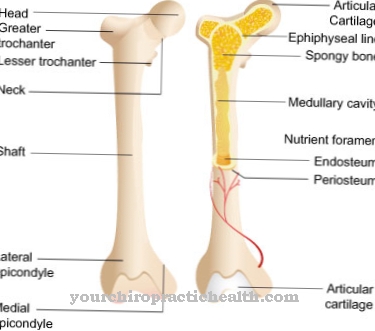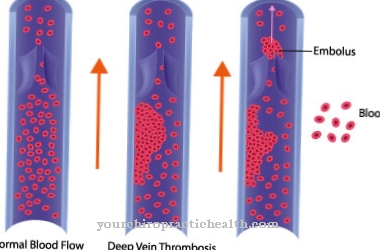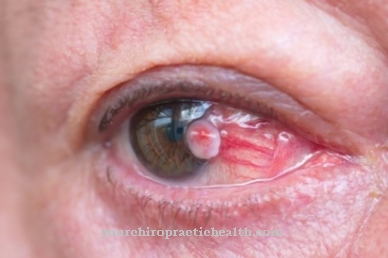As Factor V Leiden is a coagulation disorder that is common among Caucasians and is associated with an increased risk of developing thrombosis. The medical professional understands a thrombus to be a blood clot in the blood vessels. In addition to heparins, so-called coumarins are available for therapy prophylaxis.
What is Factor V Leiden?

© Axel Kock - stock.adobe.com
Factor V Leiden mutation or Factor V Leiden is a genetic clotting defect. The genetic disposition affects the coagulation factor V of the coagulation cascade. Those affected suffer from a tendency to thrombosis and therefore form blood clots much more often than other people. Factor V disease is also the most common cause of APC resistance.
Max-Hermann Hörder first discovered a deficiency in blood coagulation factor V in 1955. At that time he attributed the deficiency to the blood coagulation factor V inhibitor. In 1993, the Swedish doctor Björn Dahlbäck described the Factor V Leiden mutation for the first time. Dahlbäck named the genetic disposition for thrombosis after the city of Leiden, where he lived during his research in this area.
The FVL mutation follows the autosomal dominant inheritance. Even if only one parent carries the FVL mutation, their offspring are five to ten times more likely to develop thrombosis.
causes
Factor V Leiden is based on a point mutation. The mutation affects the gene that codes for factor V in blood coagulation. Factor V Leiden results from a point mutation in the gene for factor V (mutation F506Q or G169A). In Europe, around 2-15% of the population are heterozygous carriers of the FVL mutation. (Source: MVZ Dr. Eberhard & Partner Dortmund) Factor V is the preliminary stage of the co-factor Va, which is irreplaceable for blood clotting and supports factor Xa in the formation of thrombin.
Factor V is activated by thrombin and factor Xa via a positive feedback mechanism and is inhibited by the protein C / protein S system. When factor V mutates, it cannot be broken down and inactivated by the activated protein C. For this reason, the patient's coagulation cascade is more active and the risk of blood clots increases.
In Europe, five percent of the population are heterozygous carriers. Only 0.5 percent of the sick are homozygous carriers with mutations in both parents. The Factor V Leiden mutation only exists among Caucasians, not among other ethnic groups.
Symptoms, ailments & signs
Carriers of factor V disease are prone to thrombosis. In medicine, thrombosis is a vascular disease in which blood clots form in blood vessels. In principle, all vessels can be affected by thrombi, but blood clots in the veins are far more common. The most common thrombosis is, for example, that of the deep veins in the legs, which is a common complication, especially during pregnancy.
People with factor V disease can develop thrombosis in the arteries as well. The sinus veins in the brain are affected somewhat less often. If there is blood clot in the sinus veins, it is called a sinus vein thrombosis. Superficial vein thrombosis shows a different clinical picture than blood clots of the deep veins.
The formation of clots in superficial veins is often associated with inflammatory components. The most common symptoms of thrombosis include swelling and feelings of warmth or tension. The skin may turn red or even turn blue. Many thromboses remain asymptomatic.
In retrospect, however, asymptomatic clots can cause flooding, for example in pulmonary embolism, the most common complication of thrombosis.
diagnosis
The Factor V Leiden mutation can be diagnosed using functional tests and molecular genetics. In the functional tests, the mutation appears as an extension of the clotting time. In the case of molecular biological tests, on the other hand, the laboratory detects the causal point mutation in the DNA.
In addition, the patient is classified in the heterozygous or homozygous form as part of the analysis. This differentiation is crucial. The two forms are associated with a clearly different risk of thrombosis. Therefore, different therapy guidelines apply to the forms. If close relatives are affected by thrombosis, screening for factor V disease may be considered.
An analysis may also be indicated in patients with repeated miscarriages of unknown cause or in the case of intrauterine growth retardation. The prognosis depends on the time of diagnosis. Factor V disease can now be treated well. However, if prophylaxis is dispensed with due to ignorance, an unfavorable or even fatal prognosis can apply.
When should you go to the doctor?
If signs of a thrombosis - i.e. swelling, feelings of warmth or a blue discoloration of the skin - are noticed, a doctor is recommended. Factor V disease is a serious condition that requires rapid diagnosis and treatment to rule out complications. If complaints arise, you must go to a doctor or a clinic on the same day. A pulmonary embolism must be treated immediately by a doctor. If chest pain, shortness of breath and palpitations occur suddenly, this indicates serious illness and an emergency doctor should be alerted.
The affected person must definitely be treated in a hospital. If the homozygous factor V disease has been diagnosed, a doctor should be consulted regularly so that any thrombosis can be detected at an early stage. In the event of unusual symptoms or signs of a new blood clot, it is best to call the emergency services or the patient should be taken to the nearest clinic. If people in the family are affected by thrombosis or even a factor V disease, a preventive examination for the coagulation disorder makes sense.
Doctors & therapists in your area
Treatment & Therapy
The factor V Leiden mutation cannot be treated causally. Symptomatic therapy is available. Treatment for factor V ailments is only required in two situations. Therapy should take place in the event of acute thrombosis and certain risk situations. In this context we are talking about thrombosis prophylaxis. Heparins and vitamin K antagonists such as coumarins are mainly given to treat acute thrombosis.
Heparins dissolve blood clots and prevent blood from clotting. Coumarins reduce the production of vitamin K, which plays a crucial role in blood clotting. Vitamin K is essential for the formation of coagulation factors, so that by throttling with coumarins, the coagulation factors are only formed in small quantities. In this way, the substances reduce blood clotting.
The anticoagulant treatment lasts about six months. Patients with homozygous factor V disease have a longer therapy duration because their risk of thrombosis is higher. The permanent thrombosis prophylaxis is carried out with vitamin K antagonists in tablet form.
Outlook & forecast
The prognosis for factor V Leiden depends on many different factors. Above all, the lifestyle of the person affected is a factor in the likelihood of developing a thrombosis. A healthy lifestyle and exercise reduce the risk. Smoking and being overweight, however, increase the risk immensely. Nevertheless, thrombosis will occasionally occur even in people who behave in an exemplary manner (from a medical point of view).
Whether this becomes a danger for the person concerned depends on the time of detection. The better the formation of possible thromboses is monitored and treated, the lower the risk of a dangerous incident due to the thrombosis. Most thromboses can also be resolved without any problems.
In addition, it is also relevant whether it is a heterozygous or homozygous factor V disease: while the first only increases the tendency to thrombosis tenfold, the second increases it a hundredfold. Accordingly, people with homozygous factor V disease need to be even more attentive to their bodies.
In addition, affected women should not use the classic contraceptive pill, as this again increases the risk of thrombosis in combination with the factor V Leiden mutation. Since the disease cannot be cured causally, those affected have to deal with it for a lifetime.
prevention
Factor V Leiden is a genetic defect. Therefore, the coagulation disorder cannot be actively prevented so far. The molecular genetic analysis of the blood coagulation factors can at least be understood as a preventive measure for serious consequences of the mutation. If the analysis reveals factor V suffering, thrombi can be prevented with prophylactic therapy if necessary.
Aftercare
In the case of factor V suffering, there are usually no special follow-up options available to those affected. In most cases, the disease cannot be completely treated, so that the patients are usually dependent on lifelong treatment. Self-healing does not occur.
In general, the support and care of those affected by family and close friends has a positive effect on the course of the disease. Above all, psychological upsets or depression can be prevented. In many cases, intensive discussions with close friends are necessary.
Contact with other sufferers of factor V disease can also be very useful. The treatment of the factor V disease itself is mostly done with the help of medication. It is important to ensure that it is taken correctly and regularly, and possible interactions with other medications must also be considered.
Since the risk of thrombosis is significantly increased by the factor V disease, regular examinations should be carried out by a doctor to prevent this. In general, a healthy lifestyle also has a positive effect on the course of this disease, although a healthy diet is also necessary.
You can do that yourself
Self-treatment is not possible for factor V suffering. The patients are always dependent on treatment by a doctor in order to avoid further complaints.
As a rule, however, the intake of vitamin K has a positive effect on the disease. However, those affected are also dependent on taking blood-coagulants to relieve the symptoms of factor V disease. Early diagnosis and treatment is important for this disease. The earlier the disease is recognized, the higher the probability of a positive course of the disease.
If a pulmonary embolism occurs due to factor V disease, a doctor should be consulted immediately. In acute emergencies, an emergency doctor can also be called. The discoloration of the skin can in some cases be relieved by applying the cold.
If the Factor V disease leads to psychological complaints, the support of the patient from friends and relatives is suitable. Contact with other affected persons can also have a positive effect on the course of the disease. Since the disease also promotes the development of thromboses, the person affected is dependent on regular examinations by a doctor.












.jpg)



.jpg)










.jpg)
